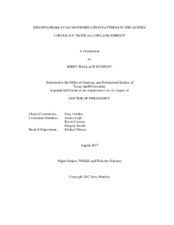| dc.description.abstract | The biogeographical history of the Afro-tropical Guineo-Congolian lowland forests during the Plio-Pleistocene is characterized by pervasive fragmentation-coalescence cycling due to global climatic oscillations. Vicariance scenarios driven by forest fragmentation have long been hypothesized as major mechanisms for the creation and maintenance of Afro-tropical avian diversity. However, the timing and center of diversification events remains unclear. Additionally, the current paradigm within the field regards the Guineo-Congolian forests as regions of little importance in creating genetic diversity patterns. The goal of this dissertation is to address, using multiple levels of evidence, potential avian diversification patterns across Sub-Saharan lowland tropical forests. Utilizing molecular data from 75 avian species, we undertook a combination of molecular and biogeographic methods to construct time-calibrated phylogenies, ancestral area estimations, haplotype networks, and diversification rate estimations.
We found substantial, geographically discrete genetic structuring in the majority of sampled avian species, much of it dating to the Pleistocene epoch. Additionally, ancestral area estimations reconstruct the lowland forests as the area of origin the ancestor of our two highest sampled genera. Diversification rates estimated for three genera recovered increasing diversification rates throughout the Plio-Pleistocene. Our results strongly indicate that lowland tropical forests are potentially harboring much more cryptic avian genetic diversity than previously hypothesized. The prevailing view of the Guineo-Congolian forests as regions that have been responsible for the creation of genetic diversity does not appear to be appropriate for many of the avian species sampled here. Specifically, understory taxa, which are heavily tied to the dark, dense parts of the lowland tropical forests showed the most substantial levels of genetic distance between geographic regions. These results highlight the importance of considering behavioral ecology when studying the biogeographic history of forest taxa. Overall, the data from this study signals that climate-induced forest fragmentation in the Plio-Pleistocene undoubtedly played a substantial role in the cyclical creation of new avian diversity in the Guineo-Congolian forests of Africa. | en |


